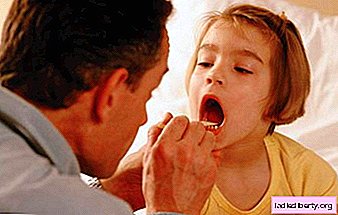
Diphtheria is an infectious disease in which the mucous membrane of the upper respiratory tract becomes inflamed and the body is severely intoxicated.
Diphtheria in children happens localized, widespread and toxic. In vaccinated children, the disease is characterized by local character and mild course. In unvaccinated babies, the disease is severe and is characterized by a high degree of intoxication. The age of the child also plays a large role in the course of the disease. Thus, in newborns diphtheria is the cause of damage to the umbilical wound; in babies up to one year, the nose is most often affected, after a year the larynx, and in children over two years, the pharynx is usually affected.
Diphtheria in children - causes
This disease is caused by a diphtheria bacillus, which, upon contact with the mucous membrane of the respiratory tract, begins to produce a toxin, which leads to a general intoxication of the body. The path of transmission of the disease - mainly airborne, but the baby can become infected through household items or toys, due to the resistance of the diphtheria stick to the external environment. Infants have passive immunity against diphtheria, which they provide antibodies breast milk mother.
Diphtheria in children - symptoms
For this disease is very typical temperature rise to 38 degrees, which is accompanied by sore throat, weakness, chills, headache. Reddened tonsils are enlarged and covered with a dense gray bloom, which, when localized, does not go beyond their boundaries, and when widespread, also affects the mucous membrane of the soft palate, the arches, and the uvula.
The toxic form is characterized by a high degree of intoxication. Defeat on the spot in this case concerns a significant surface. The pharynx blush and the tonsils increase greatly. This form is characterized by the appearance of edema of the subcutaneous fat, gradually passing to the neck, clavicle. This edema is painless and proceeds without changing the skin, however, the more it spreads, the worse the condition of the child. The most dangerous manifestations of toxic diphtheria are convulsions, vomiting, and extremely high temperatures. Such a severe course of the disease can be fatal.
Laryngeal diphtheria is characteristic of small children; it can lead to true croup. The defeat of the larynx may accompany the defeat of other organs or occur separately. The development of the process is slow, while the temperature rises, a headache appears. These symptoms are complemented by a dry barking cough and hoarseness of voice, and then his loss.
This condition leads to the growth of diphtheria films in the larynx, which eventually close the respiratory gap and make it extremely difficult to breathe. The baby's skin turns pale, he becomes sluggish, breathes superficially. If at this stage he is not provided with immediate medical assistance, then convulsions and death will occur.
Diphtheria in children - methods of treatment
For children, it is extremely important to identify the disease in time to introduce anti-diphtheria serum to save the life of the baby. Antibiotics are used as an additional treatment. Treatment of a child with diphtheria, is carried out only in the hospital.
All children and adults who have been in contact with a sick baby are examined by a medical examination, and disinfection is carried out in the apartment. Medical supervision of family members of the patient is carried out within a week after his hospitalization.
The most important measure of diphtheria prevention is vaccinations, which are carried out to all babies in children's medical institutions after reaching 3 months of age.











